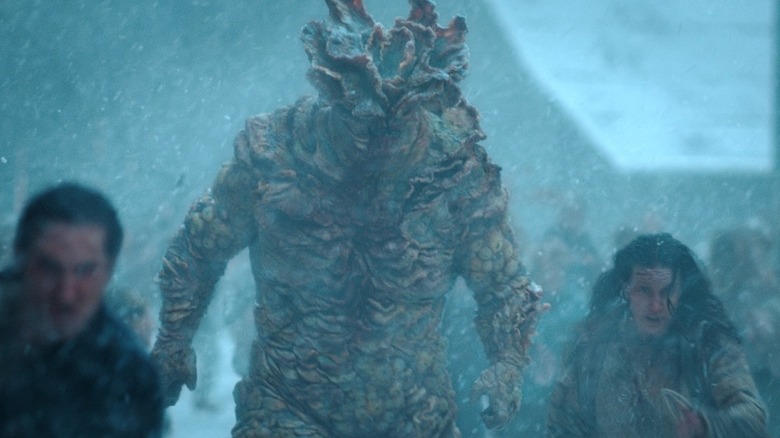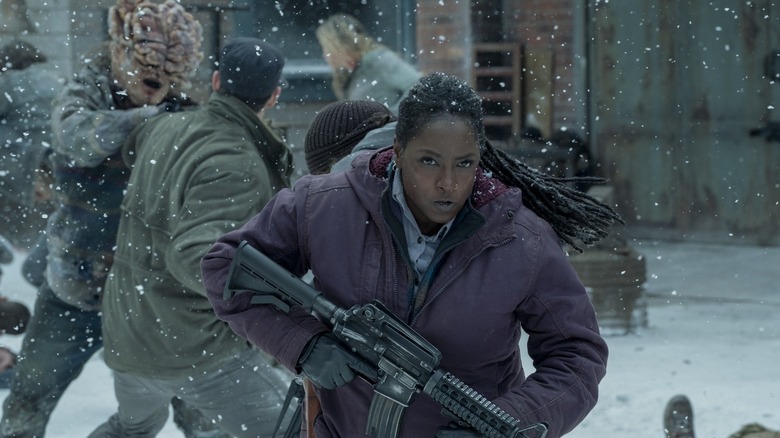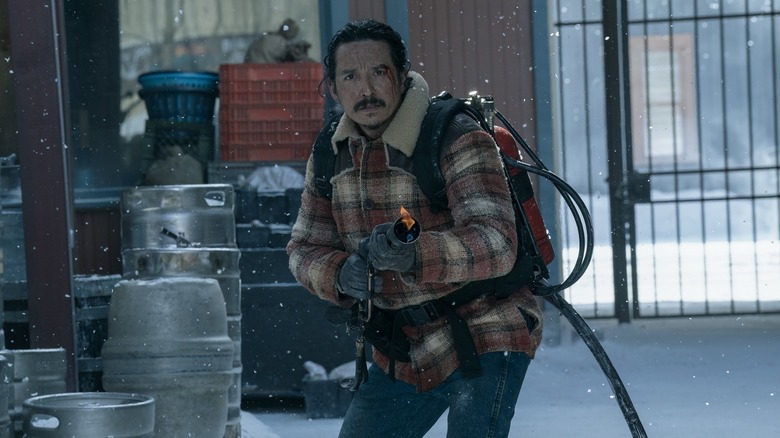Why The Last Of Us Season 2 Added A Huge Battle Scene That's Not In The Game
Put your flamethrower down if you haven't watched "Through the Valley," the latest episode to date of "The Last of Us." Spoilers incoming!
Something really big happened on "Through the Valley," the second episode of the sophomore season of HBO's massively popular series "The Last of Us" (based on the video game of the same name by Naughty Dog). I'm actually not talking about Joel Miller, the show's ostensible hero and one of the Internet's favorite dads played by Pedro Pascal, getting his head bashed in by Abby (Kaitlyn Dever). I'm talking about the assault on the survivor's stronghold in Jackson, Wyoming, where a huge, disgusting army of infected cordyceps zombies storms the town's ramparts.
Notably, this sequence is not in the video game, which does make sense. At this point in the game, the story focuses entirely on Joel's death, Abby's vengeance, and Ellie's (Bella Ramsey in the series) promise of retribution. So why add it in? According to an interview with Craig Mazin — the "Chernobyl" showrunner who helms "The Last of Us" with the game's original creator Neil Druckmann — in Vulture, the intent behind this massive (and frankly spectacular) battle sequence is to make sure viewers know that no place or person on this show is ever truly safe. (As if we didn't get that point when Abby drove a golf club into Joel's neck.)
"We wanted to feel like everybody was wounded, that everybody was struggling with the sense of recovery and rebuilding," Mazin told Roxana Hadidi, who did a deep dive on the battle sequence for the outlet. "In the game, Ellie is wounded, and we didn't want to feel like everybody else was fine. The reason to bring the fight to Jackson was to create a sense of vulnerability for everyone."
Craig Mazin said this battle sequence in The Last of Us helps remind the audience that disaster can strike any time
It's a good point, and to be honest, I love this explanation from Craig Mazin regarding the big battle in Jackson — and it's not an accident that he chose to stage this battle during Joel's death. "It's interesting to see how one person who makes a choice is being confronted by that choice, while a whole other bunch of people are feeling the direct and negative impact of that choice — not just one person, not just people that we don't know or maybe don't like, but people we love," Mazin said, referring to the fact that he made the decision to put Joel's death and this huge battle sequence in the same hour of television. "There was value in pulling the rug out from under everybody, and to have a feeling at the end of that episode that everything had fallen apart."
This whole thing also marks another small change from the game; Isabela Merced's Dina is with Joel on patrol when they meet up with Abby, and in the game it's his brother Tommy, who's played by Gabriel Luna. This frees Tommy up to fight alongside his wife Maria (Rutina Wesley), and as Wesley said, she found that she was really able to hone in on Luna as her co-star even in the midst of the understandably hectic, massive shoot.
"We're anchors for each other. Even though he could barely see my face up there on the roof, he knew I was looking at him, and I was locked onto him," Wesley revealed. Luna agreed: "You get to tell the story through these very specific action story points. Everything you see on the screen is meaningful, and every round fired is a decision being made."
If you thought this episode of The Last of Us was traumatic, you're not alone
Both Tommy and Maria take charge during this battle in two different ways. In one of the episode's most triumphant moments, Maria unlocks a bunch of cages and sends a pack of German Shepherds out to attack the infected horde (if you, like me, are super sensitive to violence against dogs in media, we do have reason to believe that the dogs are okay later on in that we don't see any of them get wounded). Tommy ends up trapped in an alleyway with a Bloater — a specific type of infected that's just as gross and huge as its name suggests — and takes it on with a flamethrower, barely surviving the ordeal. According to Gabriel Luna, this scene, which was shot with a stuntman taking blast after blast of fire, left an impression; he apparently had "visions" of a flaming man stumbling towards him for weeks after shooting. "I always make a joke of it, and my wife's like, 'Baby, I think you're traumatized,'" Luna mused. "And I was like, 'Yeah, you're probably right.'"
As horrific as the battle is, Joel's death is still the centerpiece of this episode; not only has the audience been traveling with and following Joel since season 1, but Pedro Pascal's performance as the initially unwilling father figure for Ellie is truly outstanding. That's why, as Craig Mazin revealed, he realized that he had to show the conclusion of the battle before returning to Joel rather than consistently swapping back and forth between the two events. "The moment Abby shoots Joel, you cannot leave that room," Mazin said. "Our investment in Joel is so profound that we will not care about anything if we leave right there."
At the end of the day, Mazin said that the fact that Jackson is still standing — and Tommy and Maria survive — helps offset the loss of Joel, in a strange way. Basically, it provides narrative ballance. "There's a victory ... there is something else that falls apart," Mazin said. "This is the frontier, and they figured things out, which means Jackson has a chance to win. The question is, at what cost?"
"The Last of Us" airs new episodes every Sunday at 9 P.M. EST on HBO and Max.


